Our 3rd Self-Guided Walking Tour of Ho Chi Minh City
We’re excited to present our third installment of self-guided walks through Ho Chi Minh City, this time focusing on the bustling and colorful district of Cho Lon.
This self-guided walking tour invites you to immerse yourself in the district’s rich tapestry and uncover its many stories, all at your own pace (and without spending a dime on guides.)
Prepare to discover hidden gems and witness the daily rhythm of local life as you meander through Cho Lon’s lively lanes and markets.
Ho Chi Minh City’s historical depth and cultural diversity come alive in this unique part of town, where traditional customs blend seamlessly with the city’s dynamic atmosphere. As you traverse the busy streets, you’ll get caught up in the energy that defines Ho Chi Minh City’s diverse neighborhoods.
Cho Lon stands out as a testament to the city’s cultural mosaic. Known for its delectable food vendors and rich heritage, this tour is a self-paced adventure designed to connect you with the city’s vibrant heart. It’s an experience crafted for those who love to explore urban landscapes steeped in history.
And if you like this tour, you might also be interested in:
- Our first self-guided walking tour – Unveiling the Magic of Saigon and
- Our second walking tour – See Another Side of Saigon.
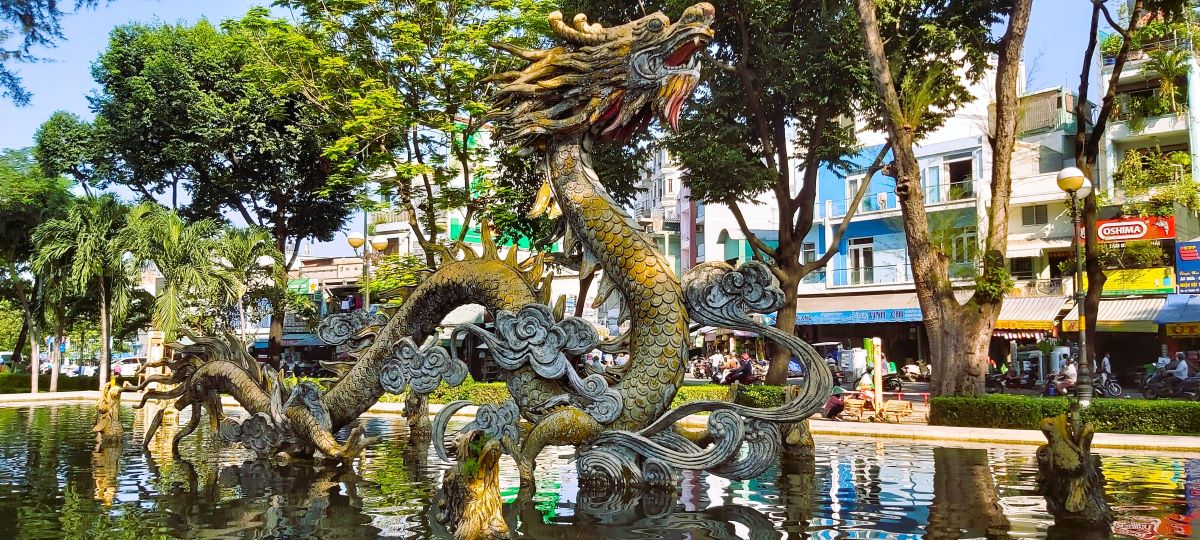
Dragon statues grace the pond on Hai Thuong Lan Ong Street
Where is Cho Lon – Saigon’s Chinatown?
Saigon’s Chinatown, known as Chợ Lớn, is a district of fascinating history, bustling commercial activity, and spiritual and cultural significance.
Chợ Lớn’s origins date back to the 18th century, when Chinese soldiers and deserters from the Qing army settled near Bien Hoa, eventually moving to what is now known as Saigon’s Chinatown. They established a vibrant community here, leaving an indelible mark on the city’s cultural landscape.
Cho Lon consists of the western half of District 5 and several adjoining neighborhoods in District 6 and District 11. It is considered the world’s biggest ‘Chinatown’ and is home to traditional Chinese architecture, temples, and abundant Chinese cuisine.
Strictly speaking, the Fito museum (the last stop) isn’t actually in Cho Lon but in District 10. However, it fits nicely into the theme of the day.
You can leave it out if you want. However, I think it’s one of the most interesting museums in Saigon, so take a peek if you can.
How long will this self-guided tour of Cho Lon take?
Exploring Saigon’s Chinatown at a leisurely pace, this self-guided tour can take anywhere from a few hours to a full day, depending on your curiosity and the time spent at each site.
With its fascinating history and bustling commercial hubs, you’ll want to take your time absorbing the traditional Chinese architecture and savoring the Chinese cuisine offered at every corner.
The spiritual and cultural experiences in Cho Lon are not to be rushed. As you meander through the Chinese temples and the vibrant streets, allow yourself to be enveloped by the area’s unique ambiance, which is both an educational journey and a feast for the senses.
If you include the Ho Thi Ky Flower Market as the first stop and the Fito Museum as your last, the tour is around 10km.
However, for just a couple of $, you can reduce that distance to around 3km if you take a Grab bike or taxi to Binh Tay Market (stop 2) and from Quan Am Pagoda (Stop ?), respectively. Taking a public bus is also an easy option. (See below in ‘costs of the tour.’)
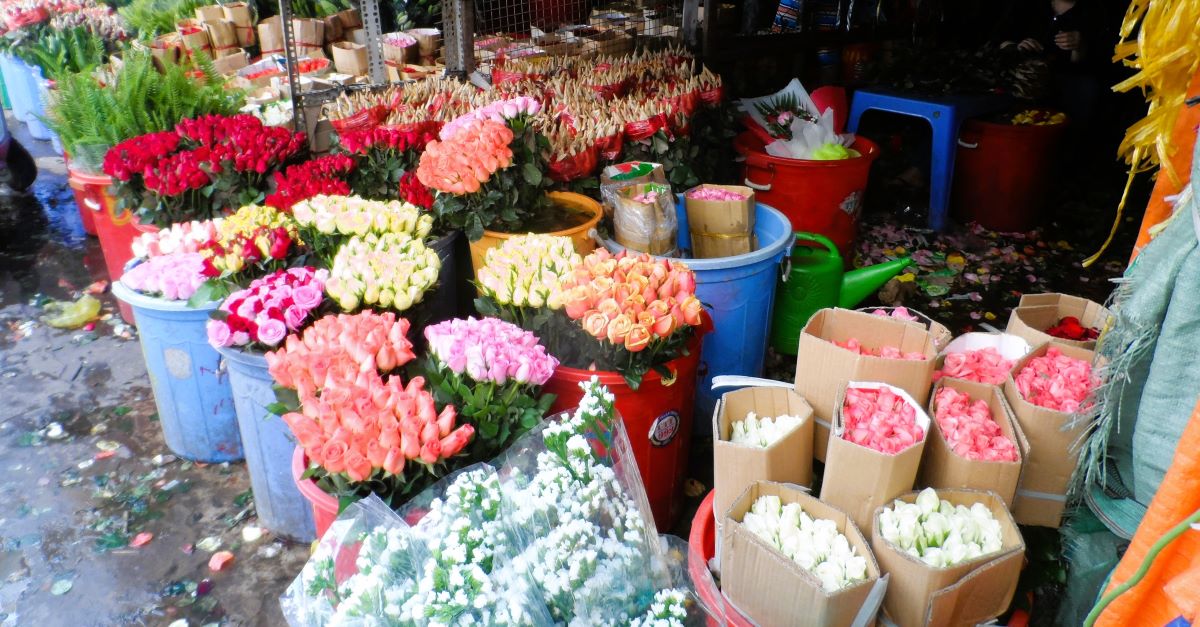
You could cut the Flower Market out of this tour. However, it's color and vibrancy make it one of the highlights in my opinion.
What Does the Cho Lon Walking Tour Cost?
The beauty of exploring Saigon’s Chinatown using this guide is that the experience can be completely free.
There are no entrance fees, except for the FITO museum, which, as mentioned above, isn’t strictly in Cho Lon. That means you can delve into the vibrant district’s cultural offerings at no cost.
However, while the tour itself is free, you may wish to purchase souvenirs, snacks, or meals along the way, which will obviously cost a few Vietnamese Dong. But the street food (and likely the souvenirs too) is slightly cheaper than in the tourist areas around District 1, so it won’t put a huge dent in your wallet.
You may also like to grab a Xe Om/Grab bike or taxi from:
Ho Thi Ky Flower Market to Binh Tay Market at the start of the day, and
Quan Am Pagoda and the Fito Museum at the end.
Both journeys are 3 to 4 km. To save one trip, you could leave Ho Thi Ky to the last stop and walk from Quan Am Pagoda (2.6km) or the FITO museum (~1.7km) in the afternoon.
However, the flower market is best seen in the early morning, and neither journey will cost you more than the equivalent of 1 USD on a Grab bike, so it’s totally worth it to save your feet and a bit of time.
Taking a public bus is also an option. Use this website (BusMap) (or download the app) and the “Navigate” function to work out the best option and where to get it from.
The entry fee to the FITO museum has gone up since I first visited it and is now 180,000 VND (~7.20 USD), but I’m pretty sure that includes a guide, so it’s still worth it (In my opinion.).
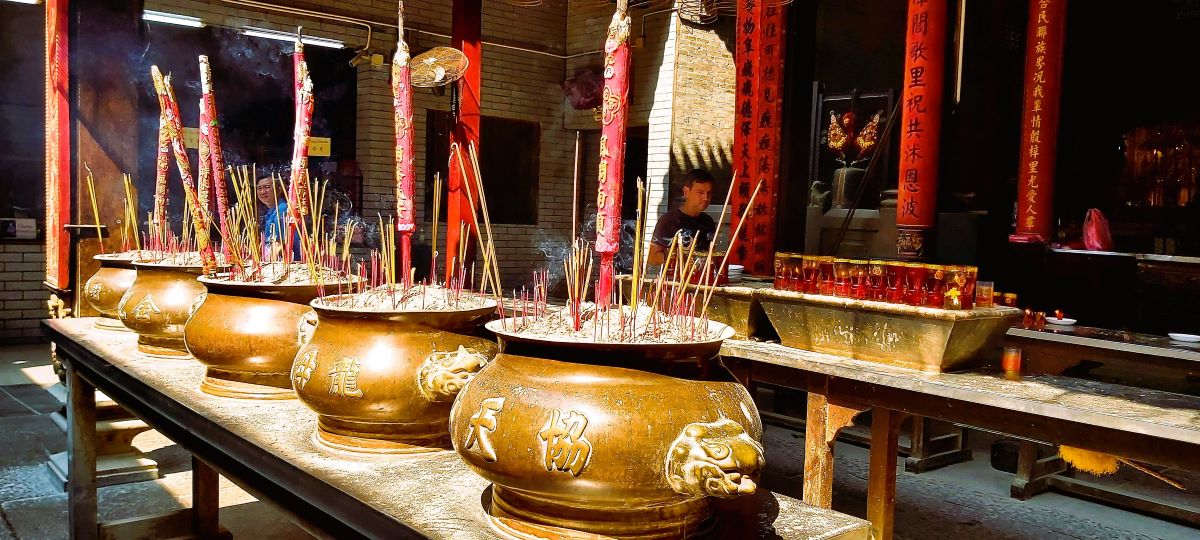
Fragrant incense in the colorful temples and pagodas is just one of the sensory pleasures you'll experience
What You Will See on this Walking Tour
On this journey through Cho Lon you’ll witness many of the sights and sounds that make this district unique. From the fragrance of a market filled with flowers to the intricate designs of ancient temples, this tour promises a sensory-rich experience. With every step, you’ll encounter the living history and cultural diversity that define this vibrant part of Ho Chi Minh City.
The route that I’ve plotted for this self-guided walking tour introduces you to:
- Ho Thi Ky Flower Market
- Cambodian Market
- Binh Tay Market and surrounds
- Cha Tam (Saint Francis Xavier) Catholic Church
- Ong Bong Pagoda
- The colorful specialty shops on Hai Thuong Lan Ong Street
- Minh Huong Gia Thanh Hoi Quan (Ming Dynasty Ancestors Village Hall)
- Tam Son Hoi Quan
- Hao Si Phuong Alley
- ChoLon Mosque
- Nghia An Hoi Quan
- Chua Ba Thien Hau
- Quan Am Pagoda, and the
- Fito Museum
I’ve also added a couple of suggestions for short breaks, and refreshments. But on this route, you’ll be spoilt for choice when you need a Vietnamese coffee shop, cafe, restaurant, or bar. And, of course, you’ll see plenty of Saigon street food as you wander the streets.
So let’s begin this tour of the highlights of Cho Lon.
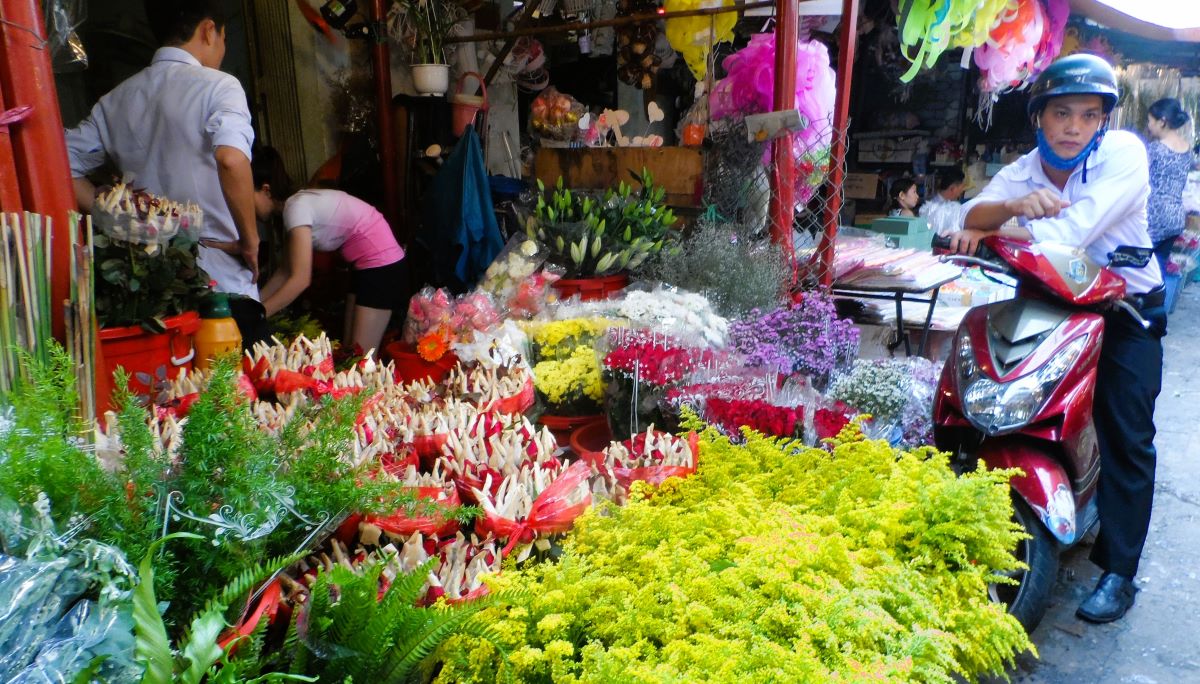
Ho Thi Ky Flower Market
Start your day at the bustling Ho Thi Ky Flower Market, a place where the beauty and fragrance of fresh flowers create a mesmerizing atmosphere.
Ho Thi Ky is the largest flower market in Ho Chi Minh City and sits at the opposite end of Cho Lon to your next stop at Binh Tay Market.
As you wander through the stalls, the kaleidoscope of colors from an array of blooms offers a visual feast.
However, remember this is a place of business. As tempting as it may be, don’t touch the flowers unless invited to.
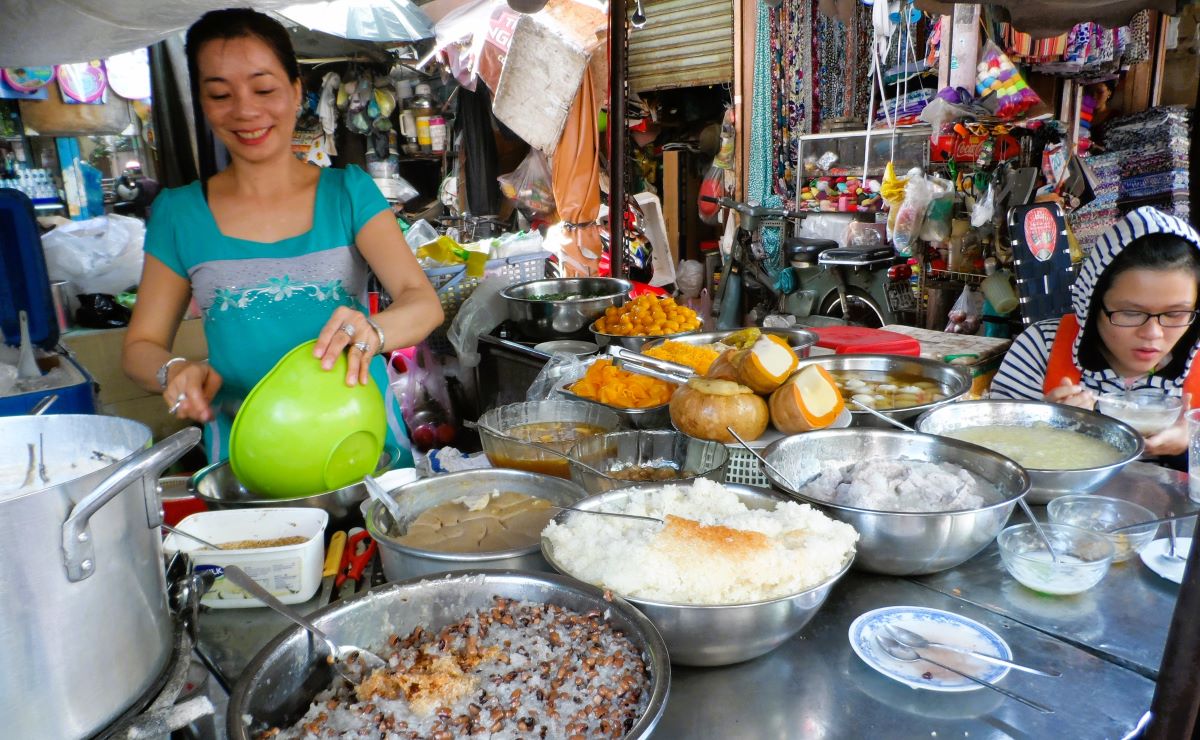
The Cambodian (Le Hong Phong) Market:
If you’re feeling peckish, head next door to the ‘Cambodian” market, down an alley to the west of the flower market. The official address is (374/51) on Le Hong Phong Street.
As well as fresh produce and various household goods, this market is famous for Cambodian food, especially desserts.
The array of sweet treats will have you drooling. One of the recommended food stalls, Quán Chè Campuchia Cô Có, sells Cambodian sweet soup, but there are several others.
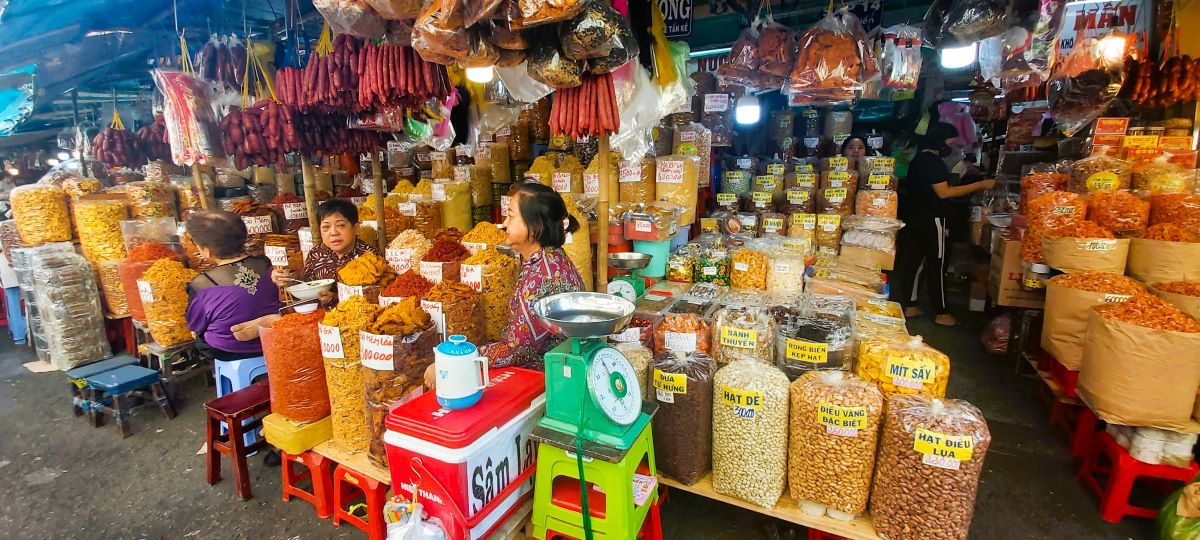
Binh Tay Market
The Binh Tay Market is the beating heart of Cho Lon and a central point of commerce in Southern Vietnam. The French colonial administration constructed the market to replace the older and smaller Cho Lon Market, which was destroyed in a fire.
Unlike Ben Thanh Market, which is more geared towards tourists, Binh Tay Market provides an authentic and vibrant local shopping experience.
As you enter the market, you’ll be greeted by the rich aroma of a vast range of ingredients used in local cuisine and discover an array of stalls and vendors selling local Vietnamese delicacies, street food, and regional specialties
The market offers an authentic glimpse into the daily life of the locals and is a treasure trove for those seeking to explore the region’s culinary diversity.
From Thap Muoi lotus seeds to exotic fruits, your senses will be overwhelmed by the vast selection of goods.
There is a clothing section on the top floor. But the ground floor is the most interesting to explore. If you’re feeling peckish, there’s a food court in the rear section where you can savor a bowl of noodles and more.
Even though the market officially opens at 6:00 am, some stalls were still setting up at 8:30 am the day we went there.
PRO TIP: – The sun rises behind the market, so if you want decent pictures of the outside, get there before 8 am when it will be shining directly into your face.
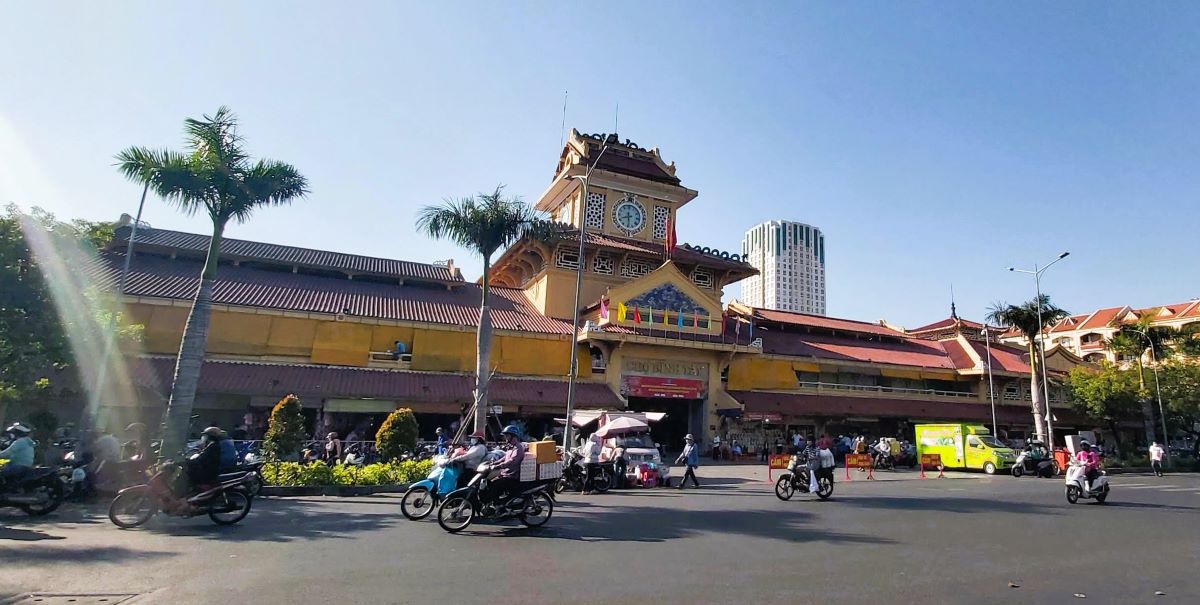
Once you feel you’ve explored enough, head for the front entrance.
The street running away from the market is Nguyen Huu Thanh Street. If you follow it, you’ll run straight into Cho Lon bus station on Le Quang Sung Street. (Note: if you catch the bus from Ho Thi Ky Market, this is where you should get off.)
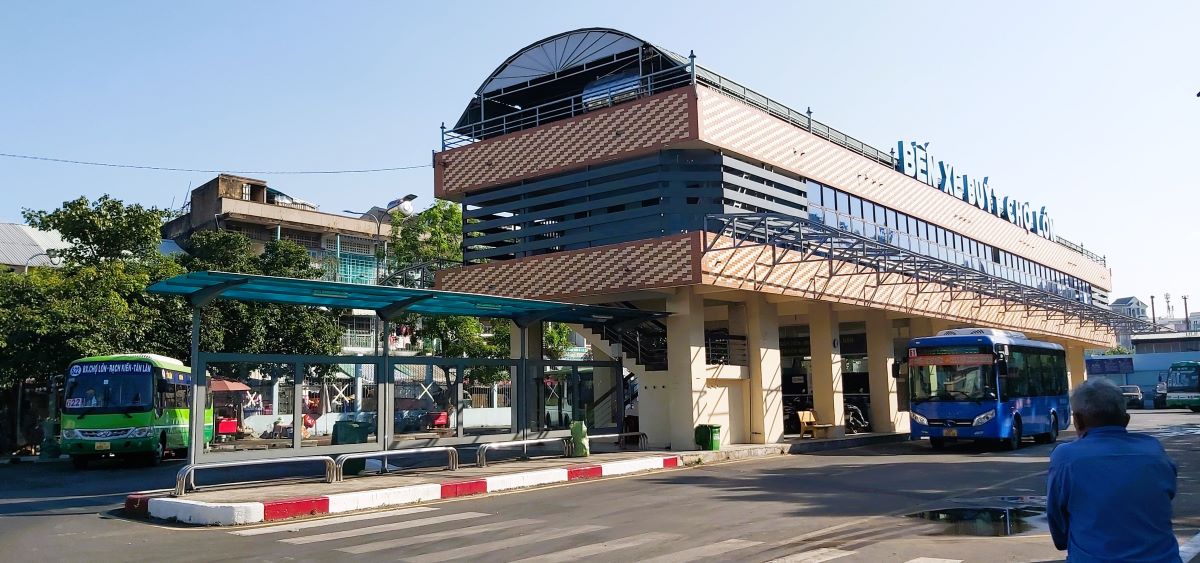
Cho Lon bus station in Saigon is huge and provides a valuable hub for those wanting to head further west of Saigon's center.
Turn right at the front of the station and head straight through the bustling fruit market.
When I visited in January (2024), the dragon fruit displays were spectacular.
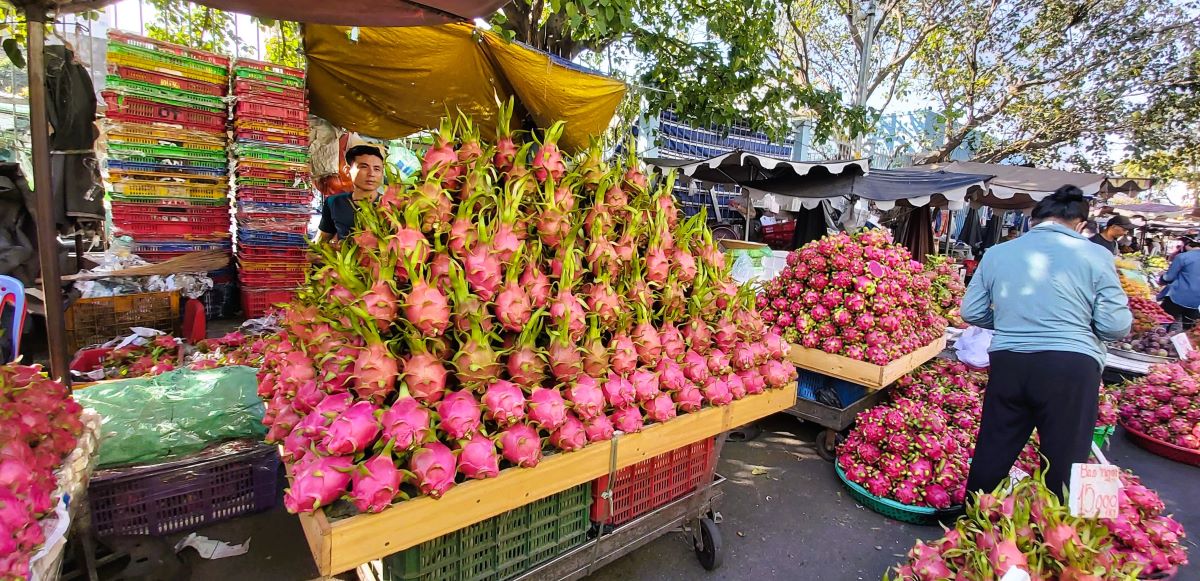
A dragon fruit stall in the market on Le Quang Sung Street - Cho Lon
Keep heading straight until you reach Hoc Lac street, and turn left. You’ll find your next stop – Cha Tam (St Francis Xavier) Catholic Church a short way down on your left.
Cha Tam Church (Saint Francis Xavier Catholic Church)
Cha Tam Church stands as a serene sanctuary amidst the busy streets of Chinatown in Ho Chi Minh City.
This Catholic Church, with its white and yellow facade, offers a tranquil escape from the hustle and bustle of the city.
It is a place where history lingers in the air. The former president of the Republic of Vietnam, Ngo Dinh Diem, and his brother Ngo Dinh Nhu sought refuge here in a doomed effort to escape a coup attempt in November 1963.
They had fled the Presidential Palace (now the Reunification Palace) through a secret tunnel network. Unfortunately for them, they were discovered by members of the coup while they were praying inside and taken into custody.
The plan was to transport them to the Vietnamese Joint General Staff Headquarters, then exile the brothers to a new country far from Southeast Asia.
However, before the vehicle reached central Saigon, the angry soldiers killed Diem and Nhu by shooting them at point-blank range and then repeatedly stabbing their bodies. Yowsers! They were obviously quite unpopular!
As you explore the church, the echoes of its storied past mingle with the present-day worship of its congregants. The church’s architecture and its role in the local community are emblematic of the cultural fusion that characterizes Cho Lon.
Unfortunately, the last time I visited (December 2023), the church was undergoing a renovation, and entry to the church itself was restricted. However, even if you can’t get in, it’s still worth exploring the grounds, especially during Christian festivals such as Christmas or Easter.
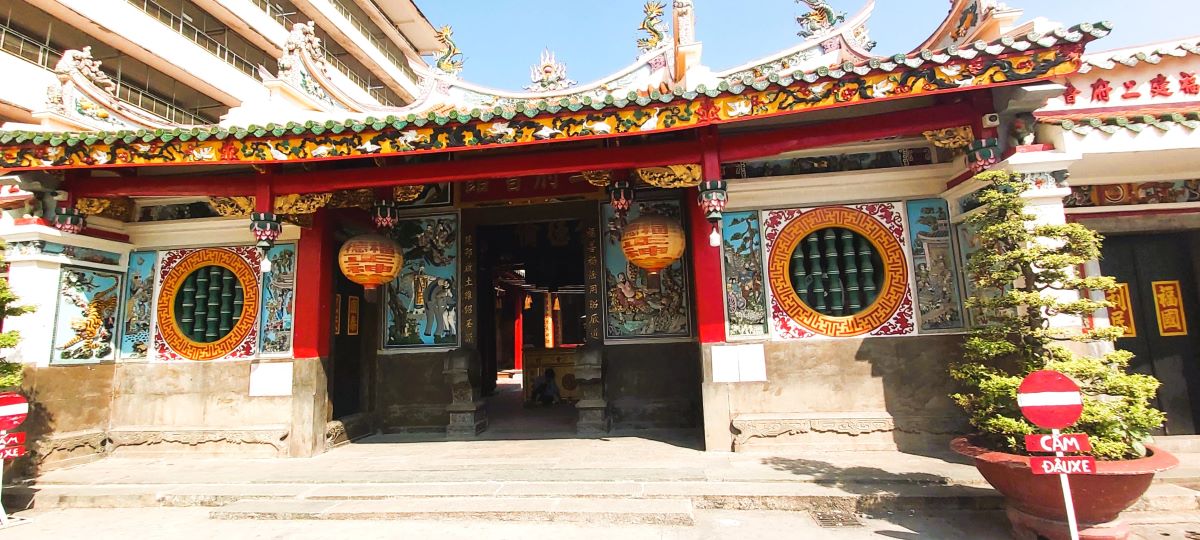
Through the gates, you'll find the decorative facade of Ong Bong Pagoda
To get to the next stop, “Ong Bong Pagoda, step out of the church’s front gate and head straight down Trung Hung Dao Street until you reach Phung Hung Street (3rd street down) and turn right. Make sure you look up occasionally, and you may spot some pf the last remnants of French colonial architecture among the old buildings.
You’ll find Ong Bong Pagoda, around 40 m on the right.
Ong Bong Pagoda (Nhi Phu Temple)
In the heart of Saigon’s Chinatown, Ong Bong Pagoda is a stunning Taoist temple dedicated to the god Ong Bon, the protector of happiness and prosperity according to Chinese beliefs.
It’s one of the oldest Chinese pagodas in Saigon. The Chinese community in Cho Lon constructed it in the early 18th century, and it holds great historical and cultural significance.
As you visit, you will be struck by the intricate details and serene atmosphere that envelop this sacred space.
A small garden separates two main areas of worship. Take your time to take in all the details of the different halls, pillars, and murals. They really are quite spectacular.

Dragon statues grace the pond on Hai Thuong Lan Ong Street
Once you’ve finished admiring the temple, exit the gate, turn right, and head straight down to the large street in front of you – Hai Thuong Lan Ong Street.
The first thing that will probably catch your eye is the massive dragon in the pond separating both sides of the street.
Carefully cross the street for a closer look and maybe take a rest and just soak up the peace of the park before continuing the tour.
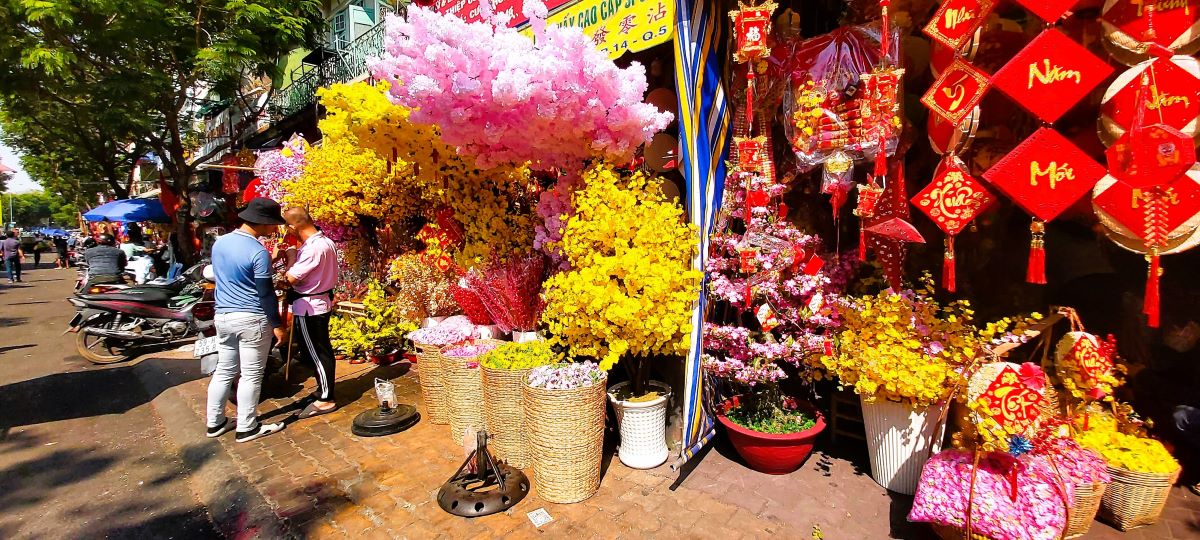
The specialty shops change their wares with the current celebrations. It was new year just before Lunar New Year when this phot was taken.
Specialty Shops – Hai Thuong Lan Ong Street
Strolling east down Hai Thuong Lan Ong Street in Saigon’s Chinatown, you’ll be amazed at the color and festiveness of the goods on sale.
The shops change their merchandise depending on the current or upcoming festivals. When I last visited, it was just before the International New Year, leading into the Lunar New Year, so there was a sea of Red and Gold decorations, lucky coins, calendars, and Tet flowers.
But whatever the season, there are always plenty of photo opportunities.
Valentine’s Day brings a swathe of red hearts and cupids, September brings colorful decorations for the Mid-Autumn Festival, and October pumpkins and witches for Halloween.
And if you come before Christmas, they will be decked out with Santa Claus, Christmas trees, and tinsel.
Minh Huong Gia Thanh Hoi Quan (Ming Dynasty Ancestors Village Hall)
Once you’ve finished admiring all the shops, keep heading east until you find yourself at a large roundabout (traffic circle) with a huge statue of Phan Dinh Phung ( a Vietnamese revolutionary who led rebel armies against French colonial forces in Vietnam) in the center.
Cross the road carefully and head down Chau Van Liem Street until you reach Tran Hung Dao Street again. Turn right and go down about 200 m until you reach number 380 – which is the gates of Minh Huong Gia Thanh Hoi Quan.
This lovely community hall wasn’t on my original itinerary, but the ornate facade made me curious.
As luck would happen, there were several members of the community inside, and my friend and I were invited to sit down and enjoy some tea.
One of the members spoke English and was kind enough to give us a personal tour.
The community hall is the oldest in Cho Lon and was founded by China’s Ming dynasty loyalists in 1789.
This Assembly Hall, along with several other similar halls around town, served several commercial, social, and spiritual functions as a business association, philanthropic organization, meeting space, and hall of worship.
The communal house was built in the traditional Cantonese style with a tiled roof and brick walls.
The many ceramic statues represent characters of a story in old Chinese tales.
The hall was recognized as a national architectural and artistic relic in 1993.
Tam Son Hoi Quan Pagoda
Turn left out of the Assembly hall and walk to the next street on your left – Trieu Quang Phuc Street. Walk around 50m, and you’ll come to Tam Son Hoi Quan Pagoda on your right at number 118.
This temple is a Taoist temple, built in the 19th century by the Fujian congregation from China.
It’s dedicated to Me Sanh, the Goddess of Fertility, so many of the worshippers are couples and women praying to conceive.
General Quan Cong, who was deified, and Thien Hau – the Goddess of Seafarers, also have their shrines here.
When you are finished, walk out of the temple and turn back towards Tran Hung Dao Street.
When you reach the main road, turn right and walk east until you come to Ngo Quyen and turn left. About 70m down on the left, you’ll find your next stop, the Hao Sy Phuong Alley.
Hao Si Phuong Alley
Hidden within the district’s streets, Hao Si Phuong Alley offers a glimpse into the local way of life.
The alley dates back to 1910 and consists of over 60 ‘tube house’ units in a two-storey configuration. Many Hoa Chinese features and ornaments have remained for multiple generations.
The alley seamlessly blends Vietnamese and Chinese influences. Buddhist prayer houses coexist with traditional eateries.
As you navigate through the alley, the vibrant community spirit is palpable, with the sounds of daily activities echoing off the walls.
Hao Si Phuong Alley is a microcosm of the district’s charm and an essential part of the walking tour.
The picture above was kindly contributed by Khuyen T from Film Production Vietnam, who was working on a collaboration with Singapore Airlines at the time (Beyond the Cabin.) If you look carefully, you can see members of the film crew.
To reach your next stop, Cho Lon Mosque, exit the alley where you came in and turn left. Walk ~ 60m to Nguyen Trai Street and turn left again. The mosque is about 400m down the street on the left.
There are many cafes and restaurants along the way if you’re hungry or need to give your feet a rest.
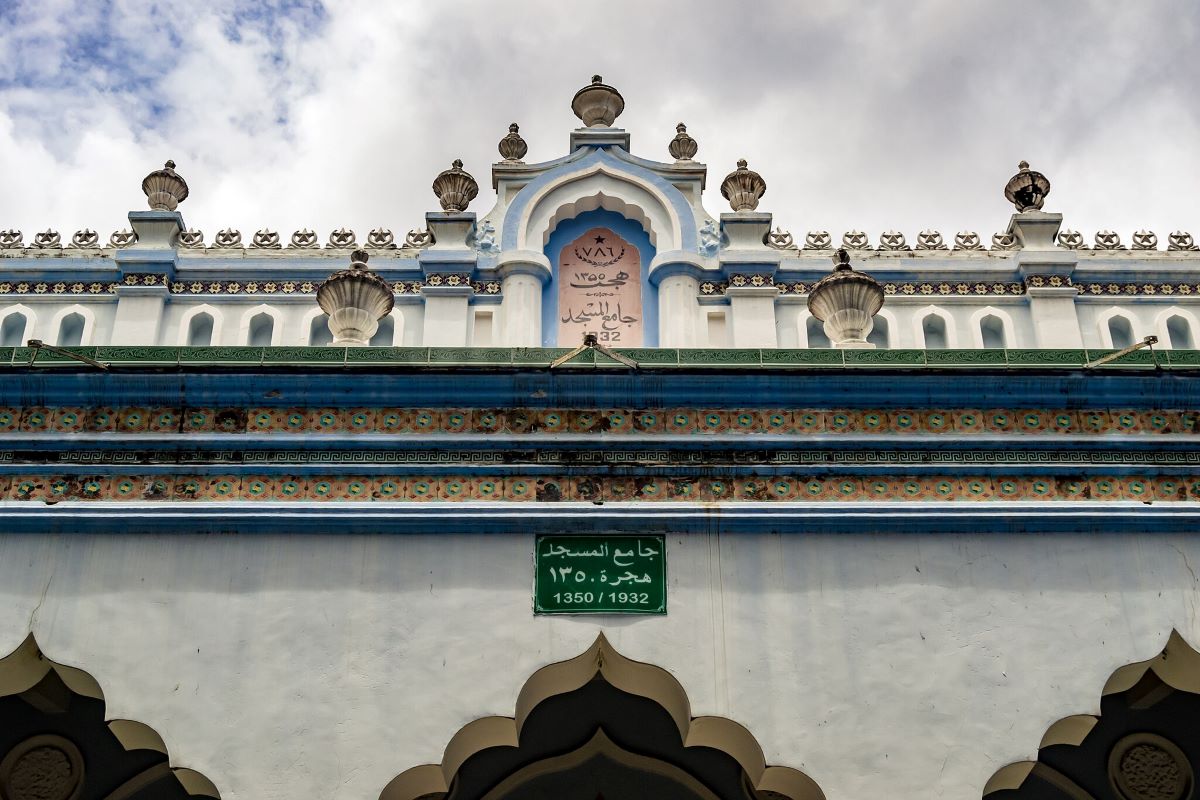
Cho Lon Mosque. Attribution - Alexander Synaptic from Taipei, Taiwan, CC BY-SA 2.0
Cholon Mosque
The ChoLon Mosque stands as a symbol of the cultural diversity of Ho Chi Minh City’s Chinatown.
As one of the few mosques in the area, it represents the Islamic community’s presence in this predominantly Chinese district.
The mosque stands with quiet dignity, offering a place of worship and peace amidst the surrounding activity.
Visitors are welcome to admire the mosque’s architecture and to reflect on the rich tapestry of religions and cultures that have found a home in Cho Lon. The ChoLon Mosque represents the district’s inclusive spirit and historical depth.
Please leave your shoes outside, (as instructed by the sign on the gate,) wear modest clothing, and do not interrupt prayer times.
Your next stop, Nghia An Hoi Quan is just 100 m further down Nguyen Trai, on the right.
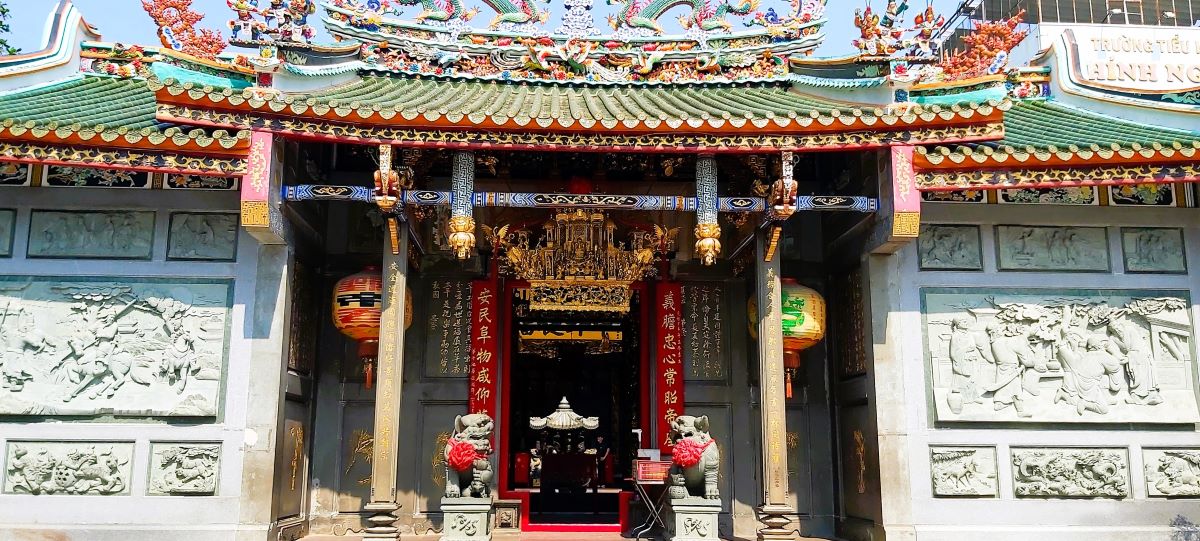
Nghia an Hoi Quan Pagoda.
Nghia An Hoi Quan Pagoda.
As you meander through Saigon’s Chinatown, you’ll stumble upon the Nghia An Hoi Quan, a place where the local community’s history and spirituality resonate.
This assembly hall, with its ornate decorations, offers a serene retreat from the bustling streets outside. Here, the air is heavy with the scent of burning incense, a constant tribute to the ancestors and the divine.
Marvel at the intricate wood carvings and colorful murals that adorn the walls of this stunning temple.
The temple is dedicated to a revered Chinese general, whose spirit is said to protect and bless the visitors. It’s a space that invites reflection amidst the echoes of a rich cultural past.
But wait, there’s more. Another 100 or so meters down Nguyen Trai on the right is your next stop. Thien Hau Pagoda.
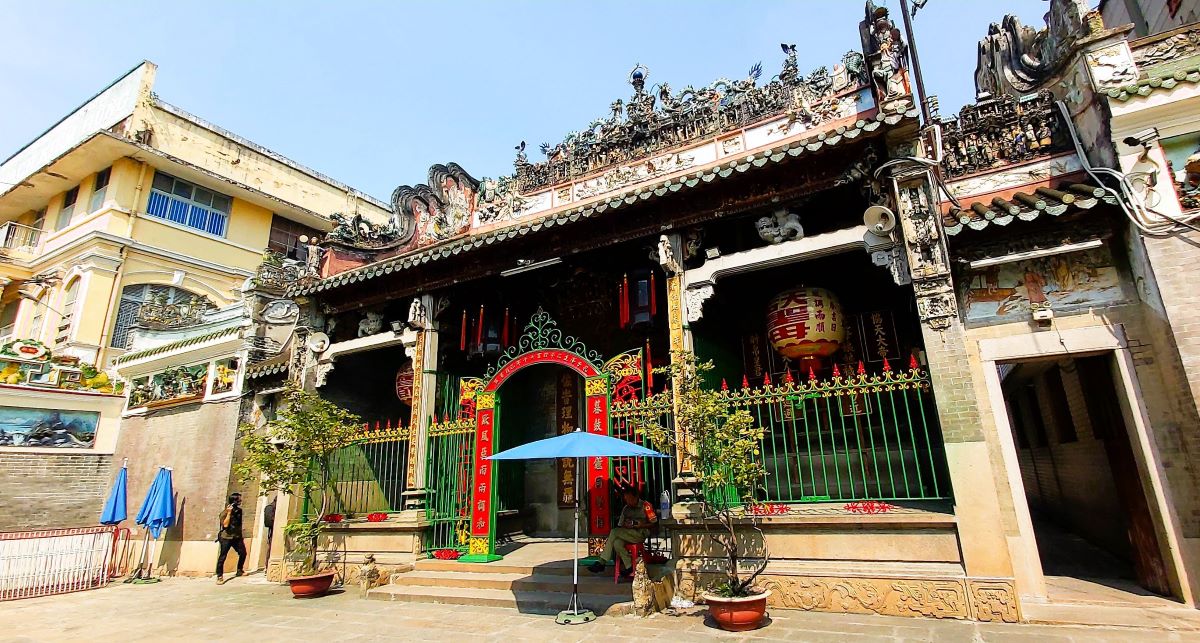
Thien Hau Pagoda - dedicated to the Goddess of Seafarers.
Thien Hau Pagoda
In the heart of Cho Lon stands the Thien Hau Pagoda. It’s dedicated to the goddess Thien Hau, revered by seafarers for her protection over the ocean.
This stunning temple is a testament to the intricate craftsmanship of the local artisans, featuring delicate porcelain figurines that dance along the roofline, telling stories of a mythical world.
Inside, altars are draped in red cloth and the air is thick with burning incense, symbolizing the prayers of the faithful rising to the heavens.
The atmosphere is one of reverence and awe, as you observe locals engaging in timeless rituals of worship and offering.
To reach the last temple on this walking tour, Quan Am Pagoda, keep walking along Nguyen Trai until you reach Luong Nhu Hoc Street.
Turn right and walk around 70 m to Lao Tu street. Turn left, and you’ll find Quan Am Pagoda about 40m down on your right.
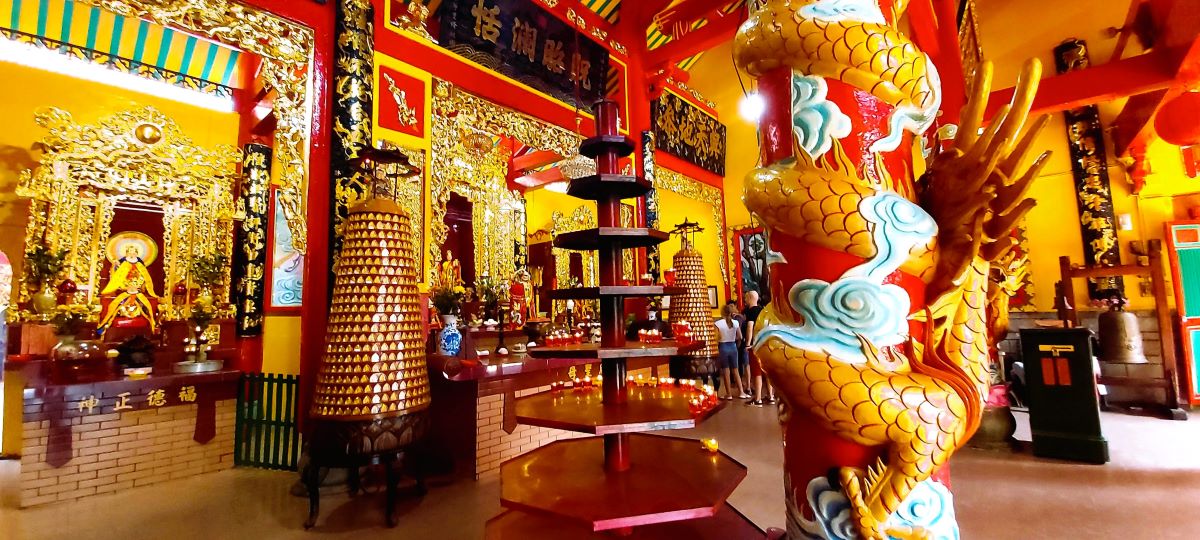
The lipstick bright internal decor of Quan am Pagoda.
Quan Am Pagoda
Quan Am Pagoda, dating back to the 19th century, stands as a vibrant embodiment of spiritual tradition in Cho Lon. This temple is dedicated to the goddess of compassion, Quan Am, also known as the Goddess of Mercy.
Inside, you’ll be enveloped by the vibrant colors and the serene presence of the benevolent deity.
As you visit Quan Am Pagoda, you’ll find yourself in the midst of a tranquil oasis, where the air is filled with the murmurs of prayer and the fragrance of fresh flowers. The pagoda offers a moment of reflection and peace, inviting you to contemplate the teachings of compassion and kindness.
That’s the last of the destinations in Cho Lon proper. If you still have some energy, head over to the wonder FITO Museum.
It’s a brisk 3.5km walk if you need exercise. However, a grab bike will probably work out less than $2 and get you there in a fraction of the time.
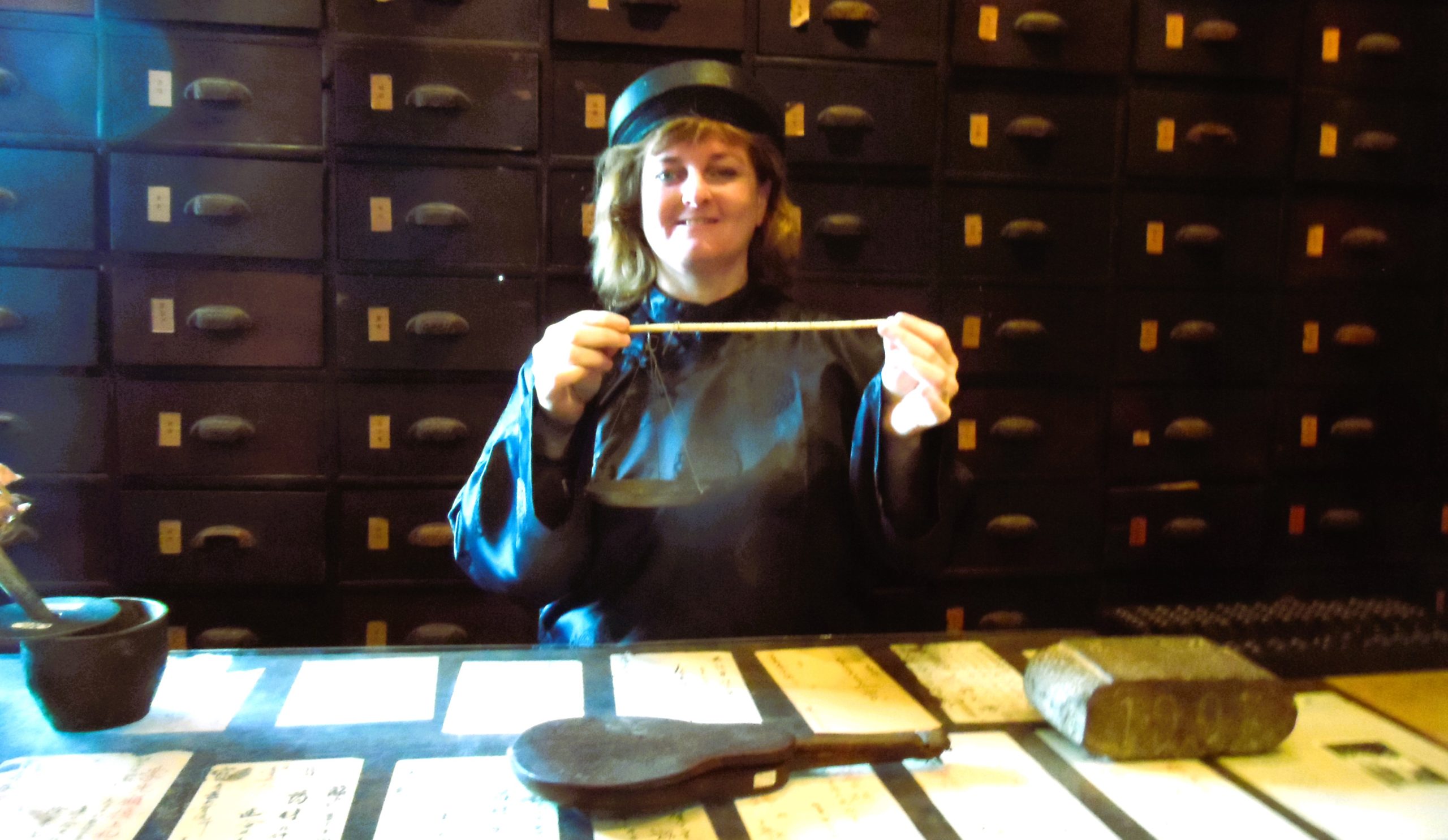
You even get to play dress up at the Fito Museum.
Fito Museum
The Fito Museum provides a fascinating glimpse into the world of traditional Vietnamese medicine. Here, you’ll discover an extensive collection of artifacts and tools that were once used by herbalists to heal and nourish. The exhibits, spread across multiple floors, unveil the evolution of medical practices in Vietnam.
Each room of the museum is meticulously arranged to showcase different aspects of the healing arts, from ancient texts to an array of traditional remedies. The museum not only educates but also immerses you in the cultural significance of Vietnam’s medicinal heritage.
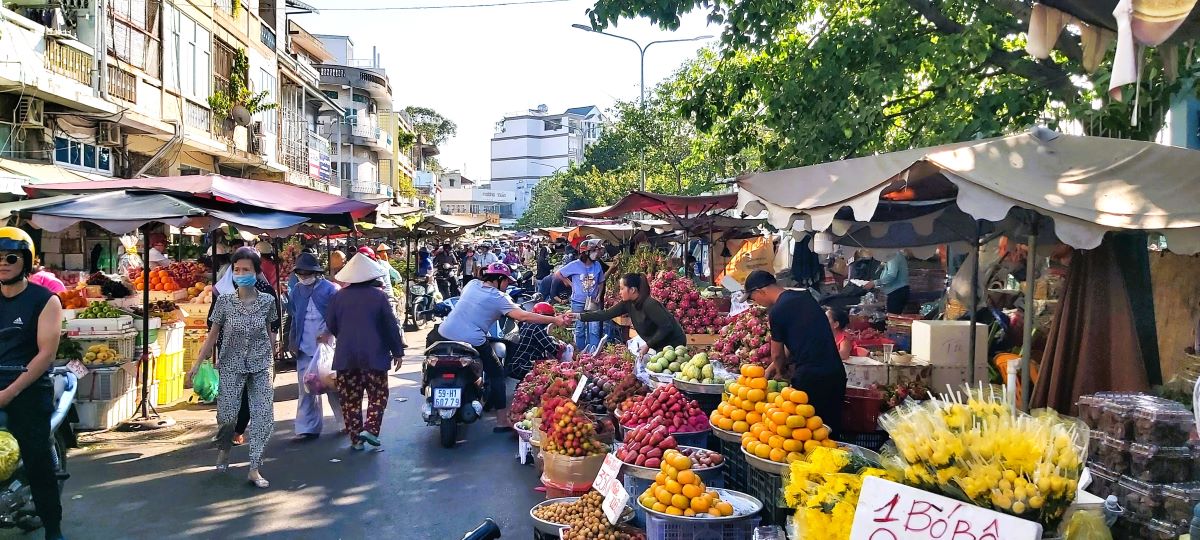
Concluding Your Ho Chi Minh City Walking Tour: What’s Next?
At the end of this walking tour in Cho Lon, you’ll realize you’ve only seen a fraction of what Saigon offers. After living here for many years, I can assure you there are a gazillion things to do and see. That’s one of the reasons I put together several more self-guided walking tours of Saigon.
Ho Chi Minh City Free Walking Tour number one focuses on District 1 and the most popular sites, including The War Remnants Museum, Reunification Palace, Notre Dame Cathedral, Saigon Central Post Office, the Saigon City Hall, The Saigon Opera House, Nguyen Hue Walking Street, the Rex Hotel, the Ho Chi Minh Statue, and Ben Thanh Night Market.
Ho Chi Minh Walking Tour 2 – See Another Side of Saigon gets to many less-visited but equally interesting sites, such as the Ho Chi Minh Museum, Saigon SkyDeck in Bitexco Tower, Saigon Fine Arts Museum, and Mariammen Hindu Temple, (and more)
However, I understand not all of you want to go it alone. So, if you’d prefer to take a guided tour for your Cho Lon exploration, there are plenty to choose from.
I’ve listed a few below, but if you hit the links and customize your requirements, you’ll have access to many more.
Free Walking Tours of Cho Lon
My favorite tour guides for a FREE tour around Ho Chi Minh City are the students from Saigon Hotpot. You can choose any of their informative FREE walking tours around town for zero cost, and they have one to District 5/Cho Lon/China Town.
The young locals are proud to show you their hometown, introduce you to Vietnamese culture, and tell you about the history of the city.
Taking a Saigon Hotpot tour is a win-win experience. You get an insider’s view of the city, and they get to practice their already excellent English skills. Any tips you give them will usually go to the organization’s current charity.
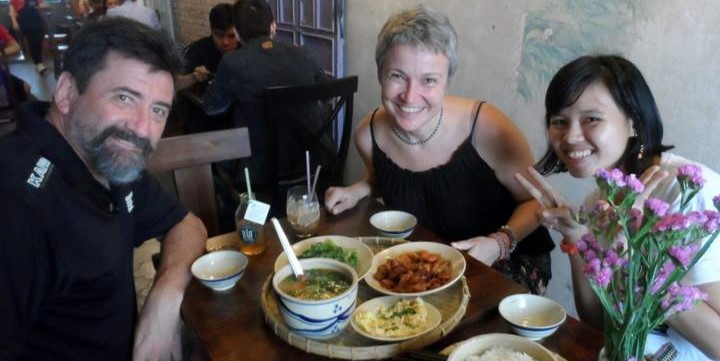
Enjoying lunch with our Saigon Hotpot guide and now friend.
Paid Walking Tours in Ho Chi Minh City
If you don’t want a free tour, there are plenty of paid walking tours in Ho Chi Minh City as well. Check out Get Your Guide and Viator to see what’s on offer. Very few, if any, will cover all of the spots I’ve included in this free self-guided itinerary around Saigon, so you may have to combine a few or customize a private tour.
But if you do take a tour, you’ll probably get a whole lot more information on each of the destinations than I’ve given you.
Non-Walking Tours Around Ho Chi Minh City
f you’re not up for walking around this crazy city, there are plenty of other ways to explore Ho Chi Minh City. I’ve added a few below:
1 Take a Saigon City Tour by Cyclo. Due to prevalent scams by private SOME unscrupulous cyclo drivers, I highly recommend an organized tour if you want to travel around the city by cyclo.
2 Take one of the many motorbike sightseeing tours around the city. While the traffic looks completely nuts, it’s not quite as bad as it looks if you know how it works. I have had a Vietnamese motorbike license for many years and never had an accident. But if you want to travel on two wheels, and aren’t an experienced rider on Asian city streets, I recommend having an experienced driver to quell some of your nerves.
3. If that all sounds too scary, there are many companies that will provide a private AC vehicle to shuttle you around on your Ho Chi Minh City exploration of the sights.
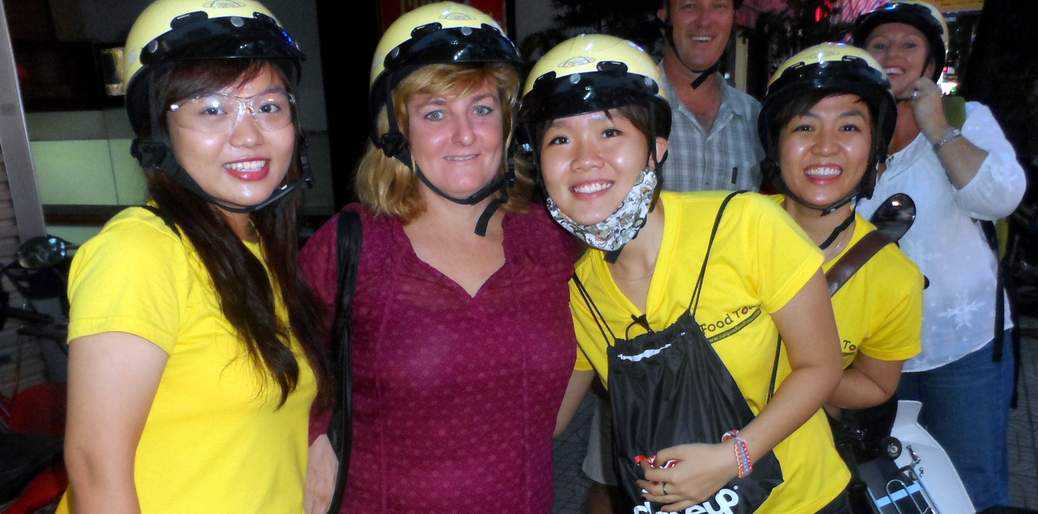
Other Amazing Experiences in Ho Chi Minh City
1. Take a cooking class. I’ve actually done three of these over the years, and all have been fabulous. Try to get one with a trip to the market beforehand and private cooking stations.
2. Take one of the many excellent food tours around town. Once again, I’ve been on several and had no fault with any. Saigon Street Eats is run by a fellow Aussie and her Vietnamese husband and has won a load of awards. But if you can book with them, (they are very popular) there are loads of others available. Take a look HERE.
3. You can combine a couple of these experiences and take a food tour by scooter at night and tick off two Ho Chi Minh City highlights in one. Once again, I’ve been on a couple of these, and they don’t disappoint. A bit of an adrenaline rush, great food, and great company.
Day Tours and Attractions Near Ho Chi Minh City
If you’ve thoroughly explored the city and have a few more days to spend, there are plenty of day trips from Ho Chi Minh City on offer. Don’t miss:
-
- Take a trip to the Cu Chi Tunnels
- Explore the Saigon River and Mekong River by boat all the way to the Mekong Delta
- Book a history tour to Vũng Tàu, a favorite resort town of the locals and chock full of war memorabilia.
And if you want to see what else I’ve written about Ho Chi Minh City and Vietnam, then head over HERE to our Vietnam Page. You’ll find plenty of information to assist with your entire Vietnam tour and with lots more to add as I get time.
Heading to Vietnam Soon?
Check out our Travel Resource pages before you start planning and booking. Everything you need in one place to save you money and travel better.
And more…
Book Your Flight
Use WayAway to find cheap flights. They are our favorite search engine because they search websites and airlines around the globe. (Including the tiny budget ones many other search engines ignore.)
Book Your Accommodation
To find the best deals and book most of our accommodation (when we’re not housesitting,) we use:
-
- WayAway
- Booking.com, and
- Agoda
If you are more into Hostels, then Hostelword is the biggest platform for those.
Don’t Forget Travel Insurance
Travel insurance will protect you if anything goes wrong before or during your trip. We never travel without it and have needed it many times. We’ve used a few companies with excellent results over the years.
Consider:
- Covermore (Australians)
- Safety Wing (All nationalities. Great for long-term travelers and Digital Nomads.)
- World Nomads (All nationalities. Great for long-term travelers and Digital Nomads.)
- Visitors Coverage (to see a more extensive range of available plans from different providers, including policies for over 60’s.)

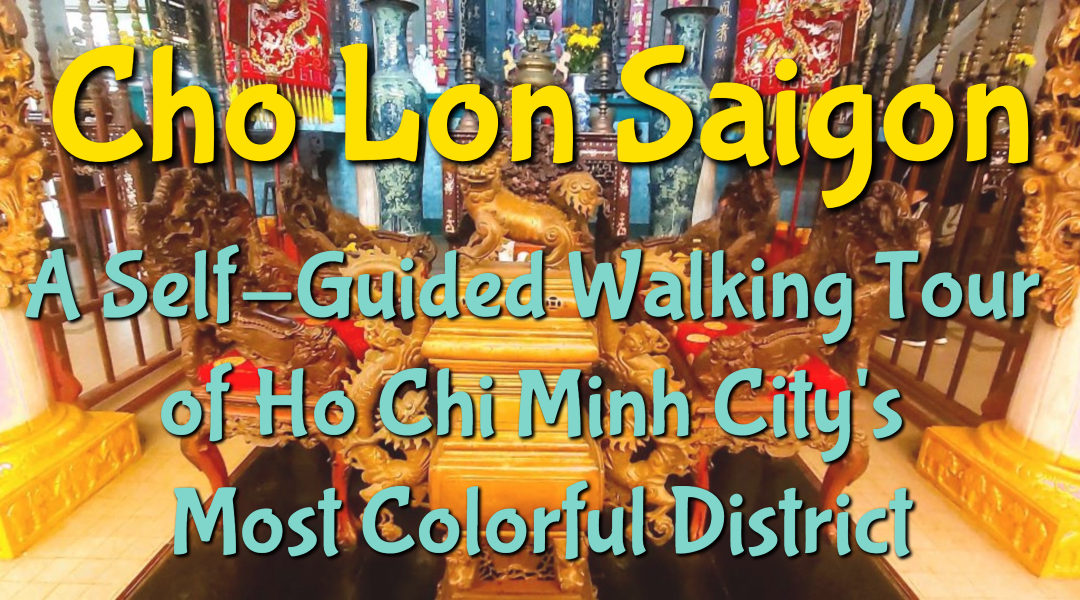
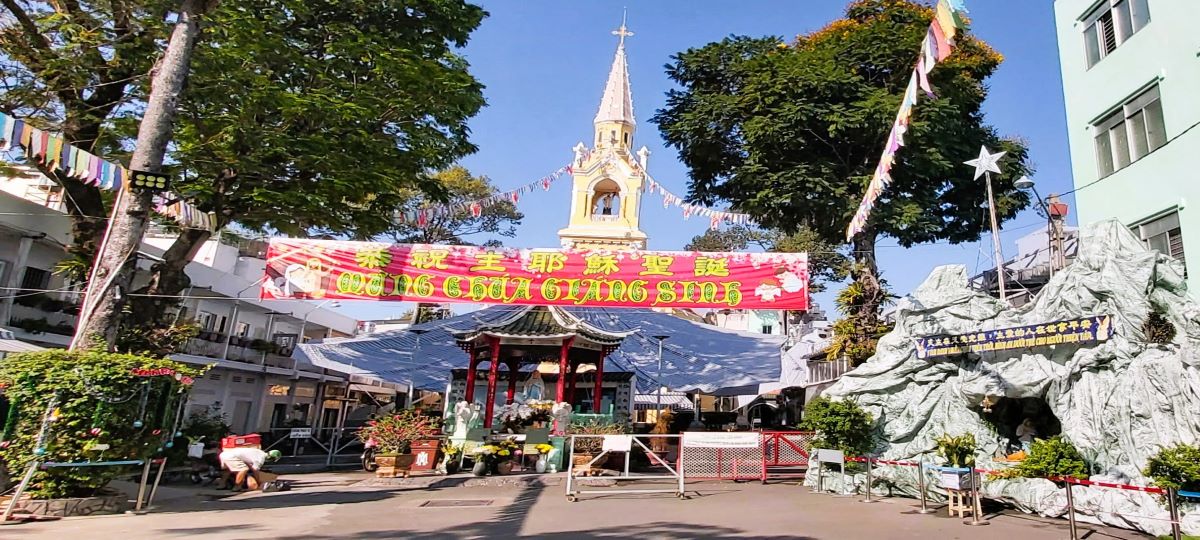
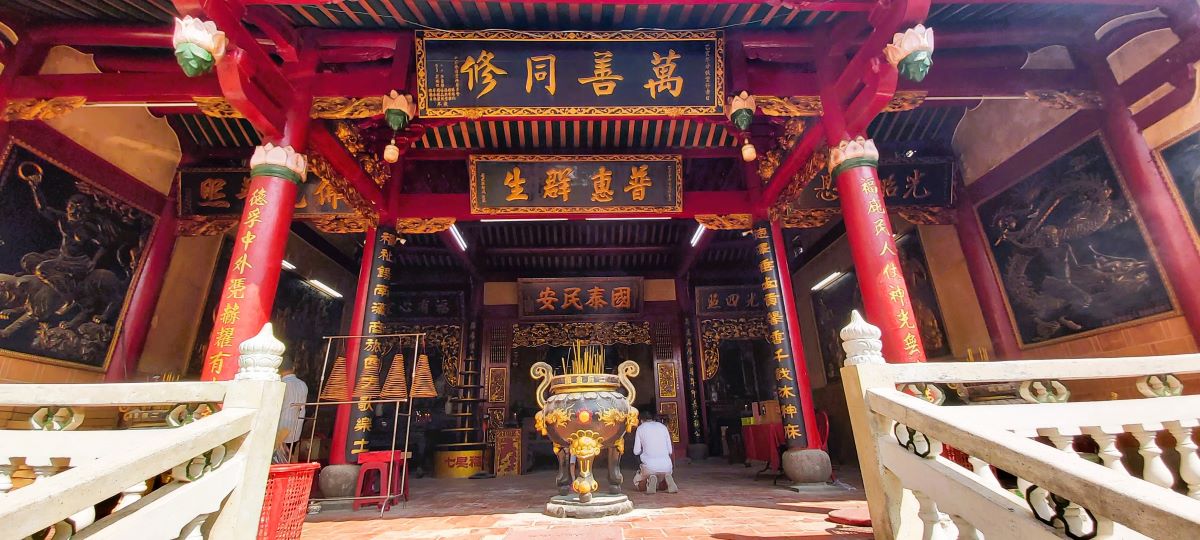
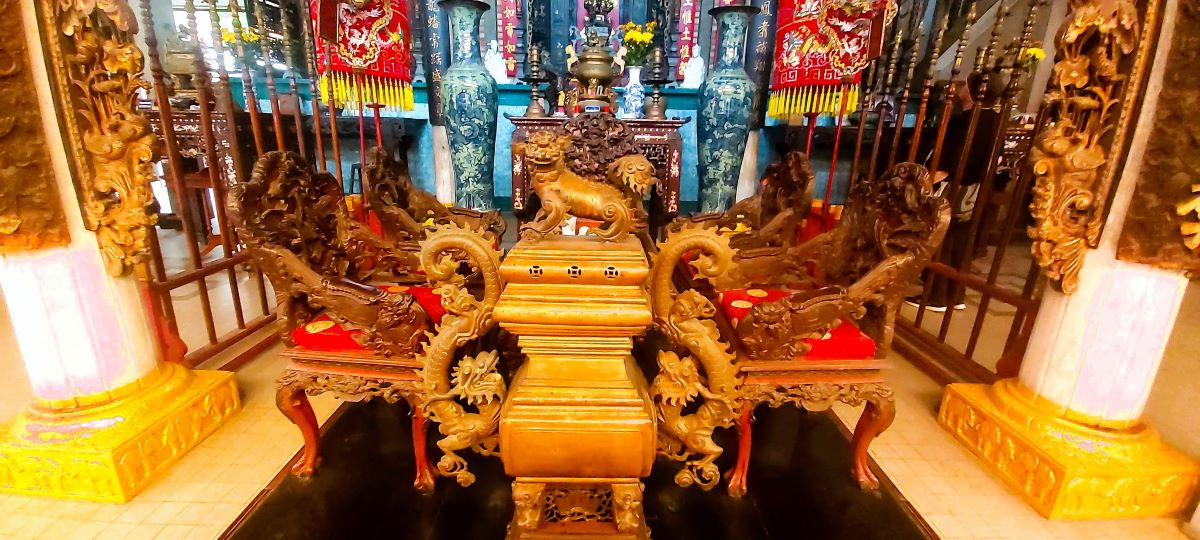
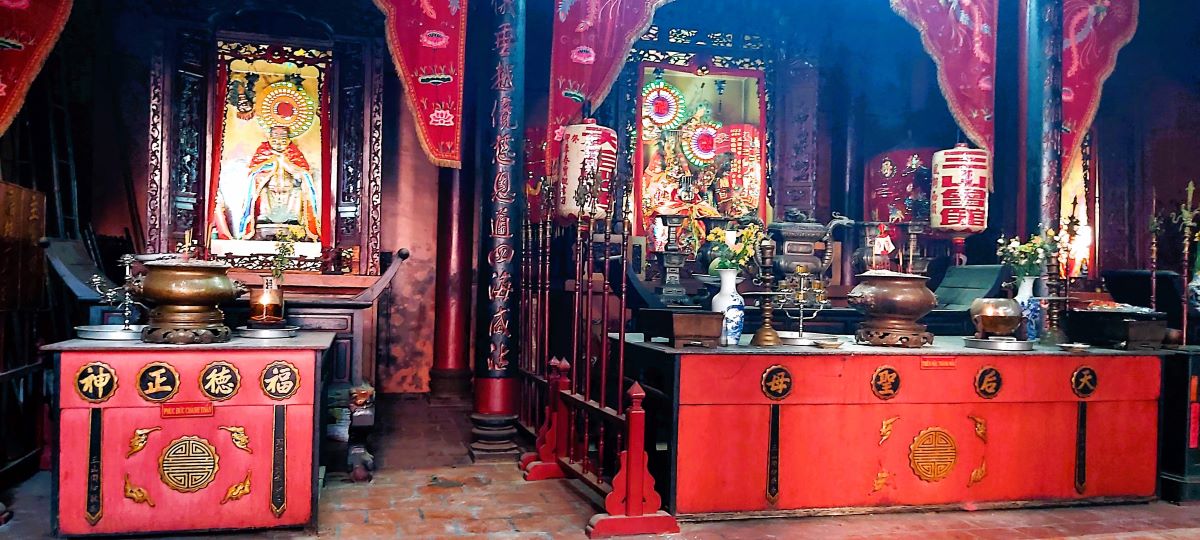
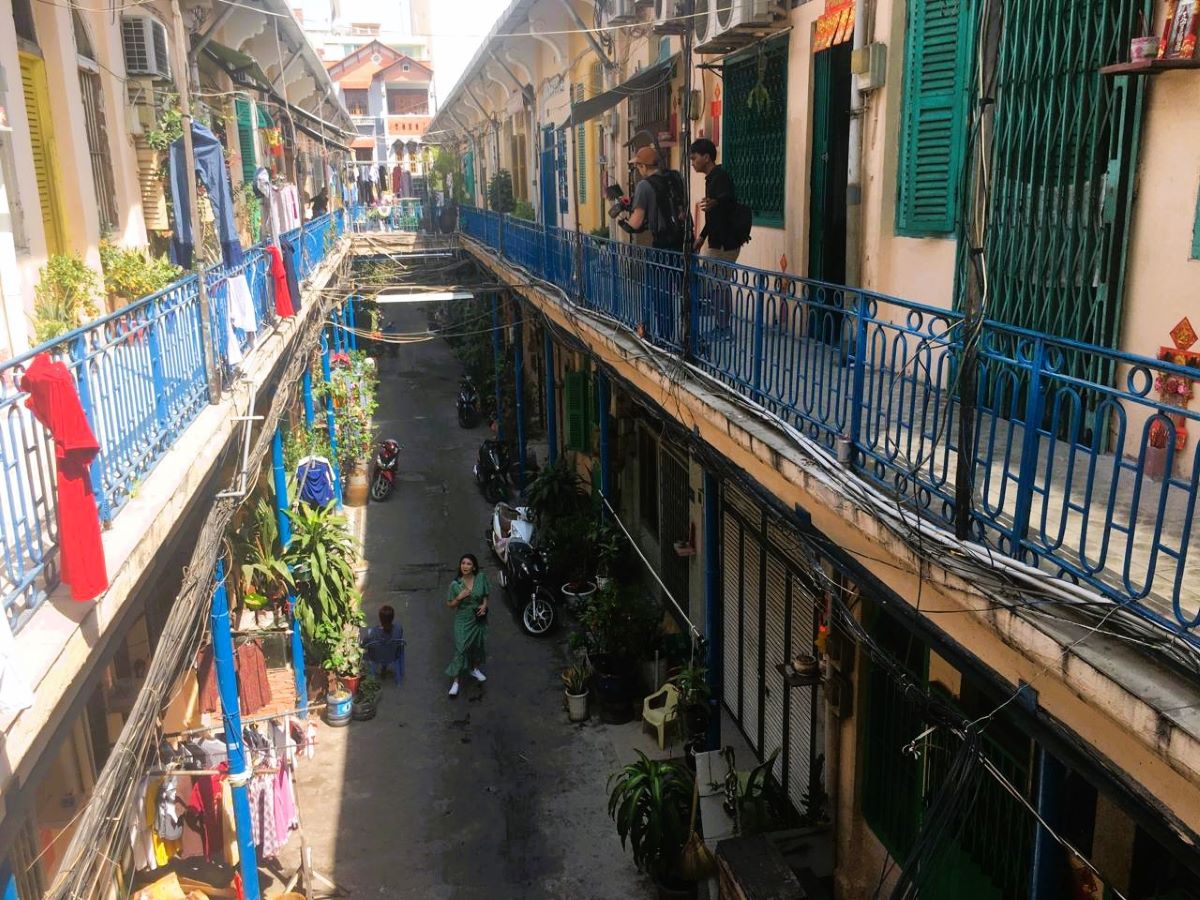




not sure about the food around Cho Lon, sounds like it’ll be way too spicy for me, anyone knows if they got plain food too?
Lots of non spicy stuff. In Vietnam the hot stuff is mainly served on the side for you to add to taste.
I’ve been on a few walking tours around Asia, and Cho Lon seems to offer a unique blend of culture and history. Keen to see how it compares.
Let us know your thoughts when you do it.
do u think this tour would be cool for someone like me who’s never really explored cho lon before?
It would be super cool! Just take your time, follow the route and soak it all in. Google Maps is your friend 🙂
Think I’ll need to wear my walking shoes for this one, or is a hoverboard allowed? Asking for a friend.
LOL. Up to you. comfortable walking shoes would be my choice in that traffic!
Absolutely adore the idea of offering free walking tours of Cho Lon. It’s such an innovative way to explore the city’s rich cultural tapestry without breaking the bank!
We don’t accompany you. It’s a self-guided tour. Just follow the instructions with Google Maps as a companion.
love your travel tips beth! gonna add this to my bucket list 😊
A whole walking tour that costs what? Free? Or my soul? Better be worth the sunburn I’ll catch walking all day.
Slip slop slap sam. Stay sunsafe and take plenty of breaks to rehydrate and you’ll be fine.
The inclusion of historical sites like Cha Tam Church and the various pagodas in this walking tour is fantastic! Appreciate the work in putting this together, timshazz.
Thankyou. These self-guided walks are always a lot of work. but the end result is super helpful for you all, so we’re happy to do it.
wow, never knew we had a walking tour for cho lon, sounds fun and cheap, gonna try it with some friends this weekend.
Enjoy. Let us know what you think.
I read about the Binh Tay Market in another article. Is it really as big as they say? Would love to know more about the food stalls there!
We went quite early and things weren’t really busy in the market itself. The food stalls were toward the back. but there is street food by the tonne in the surrounding areas.
Binh Tay is huge! You’ll find lots of options from street food to more traditional dishes. Don’t miss the pho, it’s amazing there.
hey, just wondering if the cost of the self-guided tour includes snacks or do we gotta pay extra for that? wanna plan my budget properly, thanks!
The whole thing is free and self-guided, so you pay for anything you want along the way.